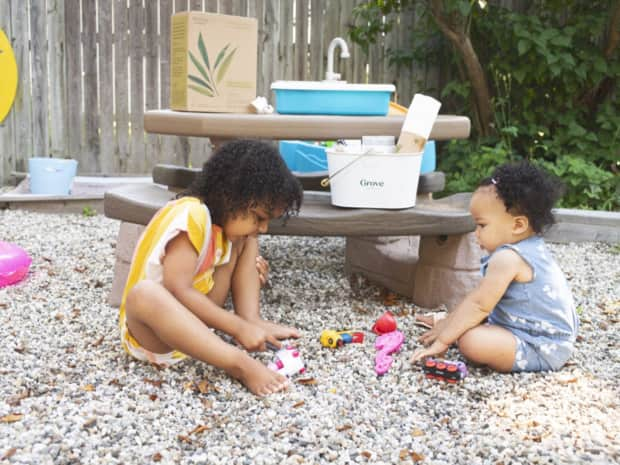
Tips for cleaning and disinfecting toys.
Last Updated: February 25, 2021
Toys go through a lot, so we've listed our best toy cleaning tips to keep them looking their best and your little one's hands germ-free.
Kids spend a lot of time touching their toys as they play, so it's important to keep toys as germ-free as possible, especially in a day-care facility or other group environment. Because toys have different types of surfaces, cleaning methods will vary.
Baby toys
Babies put their toys in their mouths as they explore them. It's also common for babies to drop their toys on the floor repeatedly. These factors make it important to wash baby toys frequently.
- Mix one-half cup of chlorine bleach with one gallon of warm water. Saturate a cloth and wipe all surfaces of plastic baby toys. Allow the toys to air-dry for 30 seconds, then rinse away the bleach solution completely.
Plastic toys
Hard plastic toys need regular sanitizing, even for older children who may not put their toys in their mouths as frequently as babies do. Disinfect plastic toys at least once a week.
- Use a sanitizing wipe or a cloth saturated in a bleach solution to wipe down all surfaces of plastic toys. Rinse away the cleanser completely.
- Wash plastic toys without crevices and screws in the gentle cycle of the dishwasher in a mesh bag.
Stuffed animals and plush toys
Clean stuffed toys about once a week if children sleep with the toys or twice a month if not. Check instruction tags for plush and stuffed toys.
- To wash stuffed toys in the washing machine, place them in a mesh bag or pillowcase and close it. Set the water temperature to warm. Dry the toys in the dryer on high heat.
- Stuffed toys with electronic components need to be surface-washed only. Using natural household cleaners is best. Pour a half-cup baking soda into a plastic garbage bag and add several stuffed toys to the bag. Squeeze out the excess air, seal the bag, and shake the toys vigorously for a minute or two. Leave the toys in the bag for 15 minutes to allow the baking soda to deodorize the toys. Remove the toys, shake off the excess baking soda, and vacuum away any lingering baking soda.
Wooden toys
Wooden toys need to be sanitized periodically. However, you can't submerse these toys due to damage that will occur to the wood.
- Mix four parts water and one part distilled white vinegar and pour into a spray bottle. Spray the mixture onto the surfaces of wooden toys, then wipe the toys dry with a clean cloth.
Electronic toys
Always follow manufacturer instructions regarding cleaning of electronic toys. If you don't have an instruction manual, try to find one online.
- Remove the batteries or unplug the toy. Wash the outer surface with an alcohol-based cleaning wipe, but don't allow moisture to enter areas where electrical components are housed. Wipe down the surface with a water-dampened cloth, and allow the toy to dry completely before replacing the batteries or plugging it back in.
Metal toys
Disinfect metal toys carefully to prevent rust. Don't place these toys in the dishwasher, especially if they have rubber components.
- Mix a half-cup of chlorine bleach with one gallon of warm water and use this solution to moisten a clean cloth slightly. Follow the procedure for cleaning plastic toys.
How often should you clean toys?
Any favorite toys that a child plays with daily need to be disinfected at least once a week. This is also true of toys a child sleeps with. Toys that children often put in their mouths need to be cleaned every one or two days. Toys children play with less frequently may only need to be cleaned once or twice a month.
- If you find unknown substances on toys, clean them right away.
- If your child, anyone in the household, or someone your child has contact with is sick, disinfect toys as soon as possible.
Resources
- Cleaning, Disinfecting, and Sanitizing Children's Toys and More
- How to Clean and Disinfect Toys, According to Cleaning Experts
- Child Safety: Washing Toys to Prevent Germs
- Prevent the Spread of Germs on Your Children's Toys
- Are You Disinfecting Your Baby's Gear Correctly?
- Child Safety: Washing Toys to Prevent Germs
- Properly Cleaning Kids' Toys
- Cleaning and Disinfection of Toys
- How to Clean and Disinfect Toys to Keep Your Kids Healthy
- Cleaning Toys Is Important
- Keep Baby Toys Germ-Free With These Cleaning Tips
- Cleaning Toys Helps Prevent Disease
- Cleaning Children's Toys
- Kids, Germs, and Handwashing
- Handwashing: Why It's So Important
- Hand Hygiene
- Handwashing: A Family Activity
- Teaching Kids to Wash Their Hands
- The Importance of Handwashing for Kids
- How to Make Handwashing Fun
Looking for more home advice, cleaning how-tos, and sustainable swaps you can make at home? Grove has you covered with our buying and cleaning guides. And let us know how if you have any cleaning questions (or share your own tips using #grovehome) by following Grove Collaborative on Instagram, Facebook, Twitter, and Pinterest.
If you're ready to make the transition to natural cleaning products, shop Grove Collaborative's cleaning essentials for the cleaning tools to tackle the job.
